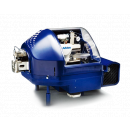应用领域:
资料类型:PDF
Bioorg Med Chem. 2011 Mar 1;19(5):1613-22. doi: 10.1016/j.bmc.2011.01.044. Epub 2011 Jan 27. Enhanced reactivity of Lys182 explains the limited efficacy of biogenic amines in preventing the inactivation of glucose-6-phosphate dehydrogenase by methylglyoxal. Flores-Morales P1, Diema C, Vilaseca M, Estelrich J, Luque FJ, Gutiérrez-Oliva S, Toro-Labbé A, Silva E. Abstract
This study examines the inactivation of the enzyme glucose 6-phosphate dehydrogenase (G6PD) by methylglyoxal (MG) and the eventual protection exerted by endogenous amines. To determine the protective effect of amines, the rate constant of the reaction of MG with the amino group of N-α-acetyl-lysine, carnosine, spermine and spermidine was measured at pH 7.4, and the behavior of endogenous amines was analyzed on the basis of quantum chemical reactivity descriptors. A 63% reduction in the enzyme activity was found upon incubation of G6PD with MG at pH 7.4. The inactivation of G6PD was even larger when the pH was increased to 9.4, revealing a weak protective effect by the amines. The results suggest that some basic residues of G6PD exhibit an anomalous reactivity, which likely reflects a shift in the standard pK(a) value due to the local environment in the enzyme. Under the experimental conditions used in the assays, this hypothesis was corroborated by mass spectrometry analysis, which points out that modification of Lys182 in the binding site is responsible for the inactivation of G6PD by MG. These results emphasize the need to search for more effective antiglycating agents, which can compete with basic amino acid residues possessing enhanced reactivity in proteins.
Copyright © 2011 Elsevier Ltd. All rights reserved.
4.4. Intact protein MS analysis For the top-down MS, an aliquot of 100 lL of the MG-treated sample solution was cleaned-up and concentrated using a C4 zip-tip (Millipore). Final elution from the zip-tip was made with 5 lL of a 78% acetonitrile, 1% acetic acid aqueous solution, and the sample was further diluted in 10 lL of an electrospray solution (methanol/ 1% FA) for MS infusion analysis on a LTQ-FT 12 Tesla (ThermoFisher Scientific). Direct sample introduction was performed by automated nanoelectrospraying using the Advion Triversa Nanomate (Advion Biosciences) at 1.65 kV spray voltage and 0.6 psi gas pressure.




